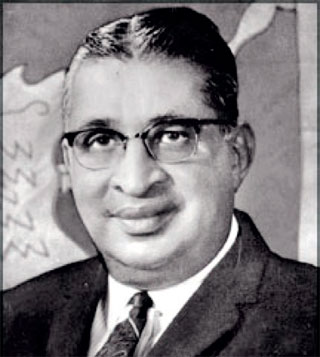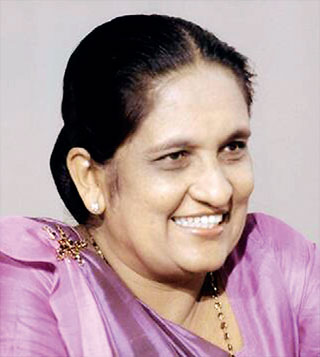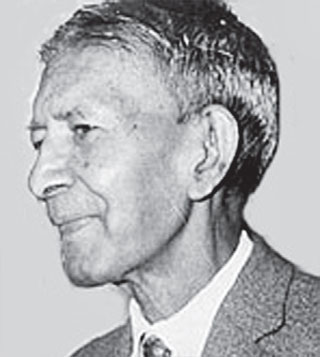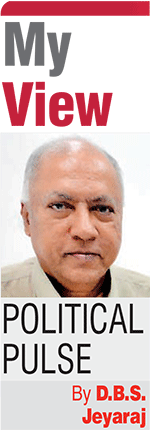Wednesday Nov 19, 2025
Wednesday Nov 19, 2025
Wednesday, 7 September 2022 02:25 - - {{hitsCtrl.values.hits}}

Dudley Senanayake

Sirima Bandaranaike

S.J.V. Chelvanayagam
|
 When the 22 March 1965 election results were announced, no single party had obtained a simple majority on its own. It was a hung parliament. As stated in the first part of this article last week, the UNP had obtained 66 seats. The SLFP came next with 41 seats. The Illankai Tamil Arasu Katchi (ITAK) was third with 14 seats. The prevailing Parliamentary arithmetic after the elections indicated that the ITAK with its 14 seats held the balance of power. What happened thereafter will be related in detail in this article’s second and final part.
When the 22 March 1965 election results were announced, no single party had obtained a simple majority on its own. It was a hung parliament. As stated in the first part of this article last week, the UNP had obtained 66 seats. The SLFP came next with 41 seats. The Illankai Tamil Arasu Katchi (ITAK) was third with 14 seats. The prevailing Parliamentary arithmetic after the elections indicated that the ITAK with its 14 seats held the balance of power. What happened thereafter will be related in detail in this article’s second and final part.
When the Illankai Tamil Arasu Katchi (ITAK) known in English as the Federal Party became the determining factor in government formation after the 1965 general election, the party was faced with a historic opportunity. It could be a “Kingmaker” by supporting the United National Party (UNP) led by Dudley Senanayake or be a “Queenmaker” by throwing in its lot with the Sri Lanka Freedom Party (SLFP) led by Sirimavo Bandaranaike. In such a situation the ITAK/FP leader Samuel James Veluppillai Chelvanayagam was ardently wooed by both sides. His arrival from Jaffna to Colombo was anxiously awaited by both sections.
The reality unknown to most was that the soliciting of ITAK/FP support had commenced even before the elections were held. Anticipating a hung Parliament and the necessity of potential ITAK/FP support to form a stable majority both the UNP and SLFP had commenced “unofficial discussions” with the FP even as the election campaign was in progress.
FP leader S.J.V. Chelvanayagam and other senior party leaders were busy campaigning in the north and east and could not be in Colombo for preliminary discussions. Chelvanayagam therefore entrusted that task to former Solicitor-General Murugeysen Tiruchelvam who was now affiliated to the FP. He was regarded as being close to the FP leader who had been the legal guardian of Tiruchelvam and his brother Rajendra when both were students.
Discreet discussions with both sides
Tiruchelvam had begun discreet discussions with both sides in Colombo even as the FP election campaign unfolded in the north and east. “Lake House” Editorial Director Esmond Wickremesinghe negotiated on behalf of the UNP with Tiruchelvam. As is well known Esmond Wickremesinghe is the father of present President Ranil Wickremesinghe. Ceylon Workers Congress (CWC) chief Saumiyamoorthy Thondaman was of assistance to both Wickremesinghe and Tiruchelvam in these talks.
Lanka Sama Samaja Party (LSSP) leaders Dr. N.M. Perera, Dr. Colvin R. de Silva and Anil Moonesinghe negotiated on behalf of the SLFP in talks with Tiruchelvam. The left parties LSSP and Communist Party (CP) were allies of the SLFP. Democratic Workers Congress (DWC) leader A. Aziz aided the LSSP leaders in these talks. On another level Tiruchelvam also conducted informal discussions with Ranji Senanayake who was the wife of senior SLFP leader Maithripala Senanayake.
Tiruchelvam apparently conducted these parallel discussions secretively and reported only to Chelvanayagam. None of the other ITAK/FP leaders knew about the talks. Interestingly, the UNP was unaware of Tiruchelvam talking to the other side. Similiarly the LSSP and SLFP did not know Tiruchelvam was talking to the UNP also. The FP negotiator however did not commit himself to either party until the elections were concluded. In any case the ultimate decision could only be made by FP Leader Chelvanayagam and approved by senior party leaders.
Importance of the ITAK/FP
Once the results were announced and the importance of the ITAK/FP in forming a government was realised, the master strategist Esmond Wickremesinghe moved fast. Along with Thondaman, Wickremesinghe persuaded Tiruchelvam to tie up the FP with the UNP. Tiruchelvam consented and informed Chelvanayagam accordingly.
Despite agreeing to go along with the UNP, Tiruchelvam did not inform the SLFP or LSSP about the alignment with the UNP. The ITAK/FP negotiator kept that option open in case the talks with the UNP failed.
Turret Road talks
Chelvanayagam and other senior ITAK/FP leaders arrived in Colombo. Esmond Wickremesinghe met Chelvanayagam personally and assured him that the UNP would honour any arrangement reached with the FP. A crucial meeting was set up between Dudley Senanayake and S.J.V. Chelvanayagam at the Turret Road (now Dharmapala Mawatha) residence of Dr. M.V.P. Peiris.
Dudley Senanayake elected to Parliament from Dedigama was accompanied by J.R. Jayewardene (Colombo South), V.A. Sugathadasa (Colombo North) and of course Esmond Wickremesinghe. The host Dr. Peiris who was made a minister in the UNP cabinet was also present. The ITAK/FP delegation led by Kankesanthurai MP Chelvanayagam consisted of Dr. E.M.V. Naganathan (Nalloor), S.M. Rasamanickam (Paddiruppu), V. Navaratnam (Kayts) and M. Tiruchelvam.
Since most of the spadework had been done by Esmond Wickremesinghe and Murugeysen Tiruchelvam, the UNP-FP talks progressed smoothly. The FP had raised areas of concern such as use of Tamil language in administration, use of Tamil in courts, de-centralisation of power to the north and east and land alienation and settlement in the north and east. Both sides agreed to terms reached in three of the four areas including the setting up of district councils. The problem was in the area of land alienation and settlement.
The FP insisted that the demography of areas in the north and east should not be altered by State aided colonisation of Sinhala settlers. The FP called it Sinhala colonisation of the traditional Tamil homeland and demanded that only Tamil speaking people should be settled in colonisation schemes in the north and east. An emotional Dudley Senanayake vehemently objected to this and blurted out, “Then where are my people to go for land?” With both sides refusing to compromise there set in a deadlock. It was almost midnight now and the UNP-FP talks seemed destined to fail.
This state of affairs changed when Dr. Peiris went out to make some telephone calls. He made a dramatic re-entry saying there was reports that Mrs. Bandaranaike was on her way to Queens House to be sworn in as Prime Minister around midnight because the FP was supporting her.
This “news” was wrong but the flabbergasting piece of information helped alter the situation drastically. There was now a sense of urgency and determination that an agreement be reached between both parties. A message was conveyed to the Governor-General William Gopallawa on behalf of Chelvanayagam that the FP was not supporting the SLFP and that it was discussing the issue of supporting the UNP with Dudley Senanayake.
Thereafter matters moved fast. After further discussions a compromise was proposed by Esmond Wickremesinghe. It was suggested that when irrigation schemes were implemented in a district and agricultural settlers were given lands, priority should be given to people of the same province. Thereafter priority should be given to people from adjacent provinces. This compromise was acceptable to both sides.
Dudley-Chelva pact
With agreement being reached, J.R. Jayewardene suggested that copies be made of the agreement and signed by the respective party leaders. The FP’s V. Navaratnam then began typing out the terms of the agreement as JR read them out aloud. Dudley Senanayake and S.J.V. Chelvanayagam signed both copies. History was only being made but was also repeating itself.
In 1957 S.W.R.D. Bandaranaike and S.J.V. Chelvanayagam representing the SLFP and FP respectively had signed an agreement. Both signatories were old students of St. Thomas’ College. Eight years later another pact was being signed by Dudley Senanayake an old Thomian and Chelvanayagam a fellow Thomian. The historic agreement became known as the Dudley- Chelva pact just as the FP agreement with the SLFP in 1957 was called the Banda-Chelva pact.
After signing the Dudley-Chelva pact both leaders shook hands. While shaking hands Chelvanayagam simply told Senanayake, “I trust you” to which Dudley replied, “I have been in politics for thirty years. I have never gone back on my promise.”
Queens House was immediately informed by telephone that an agreement had been arrived at between the UNP and FP. A letter addressed to the Governor-General on behalf of the FP was drafted and typed out at the house of Dr. Peiris. The letter stating that the FP was supporting the UNP to form a government was immediately despatched by courier to the Governor-General.
Esmond Wickremesinghe’s scoop
Meanwhile the “Lake House” press baron Esmond Wickremesinghe who had printer’s ink running in his veins was not going to let his newspapers miss out on a first-class news story. Wickremesinghe telephoned and updated the news desk at Lake House. New front pages were laid out as Esmond dictated the lead story over the phone to the “Daily News”. It was translated into Sinhala and Tamil. Lake House newspapers scooped all other newspapers on the following morning.
After agreement was reached, an elated Dudley Senanayake told Chelvanayagam that he was willing to offer three cabinet minister posts to the FP. The UNP leader said that he had wanted to offer two ministry posts to the Federal Party and one to the Tamil Congress but G.G. Ponnambalam had declined the offer. Therefore he was offering the FP all three posts. Chelvanayagam told Dudley that the FP too could not accept ministry posts as FP candidates contesting polls had pledged that they would not accept cabinet portfolios until their ideal of Federalism was realised.
Dudley however was insistent. He said that without the participation of the FP the Government which he was going to be head of would not be a “national” Government. He urged the party to re-consider its decision. Chelvanayagam then replied that he would place the UNP leader’s request before the FP Parliamentary group for consideration. The FP then departed from Turret Road in the wee hours of the morning.
It had now become clear that Dudley Senanayake was going to form a Government with the help of the FP and other parties. Still the LSSP made a last ditch effort to reverse the situation. Dr. N.M. Perera and the DWC’s Aziz went to Tiruchelvam’s house in Rosemead Place. While N.M. waited in the vehicle, Aziz went in and met Tiruchelvam. The FP negotiator told the DWC leader that the party was going to support the UNP. A crestfallen Aziz turned back.
LSSP leader Dr. N.M. Perera would not give up still. He went along with Anil Moonesinghe to the Alfred House Gardens residence of Chelvanayagam. NM offered to get the 1957 Banda- Chelva agreement implemented in full if the FP supported an SLFP-led Government. Chelvanayagam politely refused saying the party had pledged its support to the UNP.
Joint letter of support
Dudley Senanayake also sought and obtained a letter of support from all party leaders addressed to the Governor-General. The joint letter stated: “The results of the General Elections show the country has endorsed our actions in defeating the coalition govt. in Parliament on December 3rd. We represent an overall majority in the house of representatives. We will support a National Government under the leadership of Mr. Dudley Senanayake the leader of the United National Party who has pledged to protect and preserve democratic freedom and to rescue the country from the economic and other difficulties that now face us.”
It was signed by Dudley Senanayake (UNP), C.P. de Silva (SLFSP), S.J.V. Chelvanayagam (FP), GG Ponnambalam (ACTC) and Philip Gunawardena (MEP).
The letter signed by Dudley Senanayake and other party leaders was accepted and perused by Governor-General Gopallawa. After being satisfied, Gopallawa then telephoned Sirima Bandaranaike and informed her that the UNP had the necessary majority. Mrs. Bandaranaike said she would come to Queens House and submit her resignation. Dudley Senanayake was asked to call over at Queens House and take his oaths as Prime Minister.
Mobs outside Queens House
There was still a simmering problem. Supporters of the SLFP and LSSP were mobbing the areas outside Queens House in Fort (like the “Aragalaya” protesters mobbing Presidents House). Their intention was two-fold. One was to prevent Sirima Bandaranaike from meeting the G-G and resigning. The other was to block Dudley Senanayake from entering Queens House and being sworn in as PM. A few ex-ministers were also mingling with the boisterous crowds.
Governor-General William Gopallawa then telephoned the SSP Colombo Ivor Van Twest and instructed him to clear the area of all “obstructions”. Van Twest delegated the task to Assistant Superintendent of Police V. Vamadevan who went to the spot with a Police contingent. An ex- minister accosted Vamadevan and got into a verbal duel with the young ASP. He threatened Vamadevan in obscene language referring to his Tamil ethnicity and demanded that the Police withdraw immediately. Vamadevan did not budge and with the aid of his fellow cops pushed back the mobs beyond “Ceylinco House” towards Galle Face.
The way was cleared by the Police for Mrs. Bandaranaike to submit her resignation to the Governor-General. After she did so and left Queens House, Dudley Senanayake was asked to call over. Anticipating trouble the Strongman of Northern Colombo V.A. Sugathadasa took over the security of Senanayake.
|
Sugathadasa escorts Senanayake
The UNP leader was escorted by Colombo’s former Mayor Sugathadasa and a convoy of vehicles packed with some toughies. The convoy took a route from Kotahena to reach Queens House. While the protective escort vehicles and their occupants remained outside Dudley and Sugathadasa went in. Dudley Senanayake was sworn in as premier for the fourth time.
Meanwhile the ITAK/FP parliamentary group met in Colombo. After Chelvanayagam briefed all the MPs about the agreement reached with the UNP, the party leader informed the gathering about the offer of three ministry posts. Chelvanayagam said that if the MPs were willing the party could accept the offer. Chelva suggested that the FP president S.M. Rasamanickam and party secretary A. Amirthalingam along with M. Tiruchelvam could become ministers. Since Tiruchelvam was not an MP he could be made a Senator to become a cabinet minister said Chelva.
There was a howl of protest. V. Navaratnam the Kayts MP protested strongly against the suggestion to accept ministry posts. He was supported by Parliamentarians like C. Rajadura (Batticaloa), K.P. Ratnam (Kilinochchi), and C. Kathiravetpillai (Kopay) who argued strongly that the party should not join the cabinet. It was pointed out that the Tamil Congress which had kept out of the cabinet would now vilify the FP as traitors for joining the Dudley Senanayake-led UNP Government just as the FP condemned G.G. Ponnambalam as a traitor for joining the DS Senanayake-led UNP Government earlier in 1948. Both Rasamanickam and Amirthalingam said they would not become ministers.
Chelvanayagam then pointed out that the party having a minister in cabinet would be beneficial in ensuring the smooth implementation of the Dudley-Chelva agreement. He was supported by Dr. E.M.V. Naganathan who observed it was easier to work from within Government ranks rather than from outside. A compromise was reached finally.
Local Govt. Minister Tiruchelvam
As the FP candidates had vowed not to accept ministerial office and all elected MPs were bound by such oath, it was decided that a person who had not made such a pledge could accept a cabinet portfolio. The FP would only accept one ministry and not three ministry posts. It was unanimously resolved that Tiruchelvam should represent the FP in the National Government. He would also be made a member of the upper house or Senate. The FP requested the Home Affairs Ministry for Tiruchelvam but Dudley had promised that to former premier W. Dahanayake. So Tiruchelvam became minister of Local Government in the National Government.
“Hath Haula” Govt.
The National Government of Dudley Senanayake in 1965 was a seven-party coalition comprising the UNP, FP, SLFSP, MEP, ACTC, JVP and CWC. It was popularly referred to as the “Hath Haula” (Seven Antagonists). Government Representatives of the UNP, SLFSP, FP and MEP were appointed as ministers. The JVP’s Kusuma Rajaratne was made a deputy minister. The Tamil Congress did not accept ministerial office but the party’s Uduppiddy MP M. Sivasithamparam became deputy speaker and chairman of committees in 1968.
The CWC had campaigned strenuously for the UNP in the elections but did not field any candidates of their own. Dudley Senanayake nominated the CWC’s S. Thondaman and V. Annamalai as appointed MPs. R. Jesudasan of the CWC was made Senator. The CWC was the seventh member of the UNP-led National Government. The National Government of Dudley Senanayake with 17 cabinet ministers was sworn in on 27 March 1965.
The “Hath Haula” National Government was the first Government since Independence to complete its five-year full term of office from 1965 to 1970. There were schisms when the JVP Deputy Minister Kusuma Rajaratne resigned her post in 1966 as a mark of protest against the Government bringing in new laws to facilitate the use of Tamil in administration. In 1969 the FP quit the Government and Tiruchelvam resigned as minister over the refusal of Dudley Senanayake to declare the Koneshwaram temple precincts in Trincomalee as a sacred area. The ITAK/FP sat in the Opposition but did not vote against the Government. The Dudley Senanayake Government also went back on its promise to introduce the District Councils scheme.
This then is the story of the seven-party national government being formed in 1965. It was a coalition of diverse political elements. Only a statesman of Dudley Senanayake’s calibre could have managed the inherent contradictions within that Government.
National Government routed at 1970 polls
The National Government of Dudley Senanayake completed its full term and confidently went to the polls in 1970 seeking a renewed mandate from the people of the country. The voters of Sri Lanka however had other ideas and passed harsh judgement on the performance of the National Government. The UNP was routed at the 1970 polls.
(The writer can be reached at [email protected].)